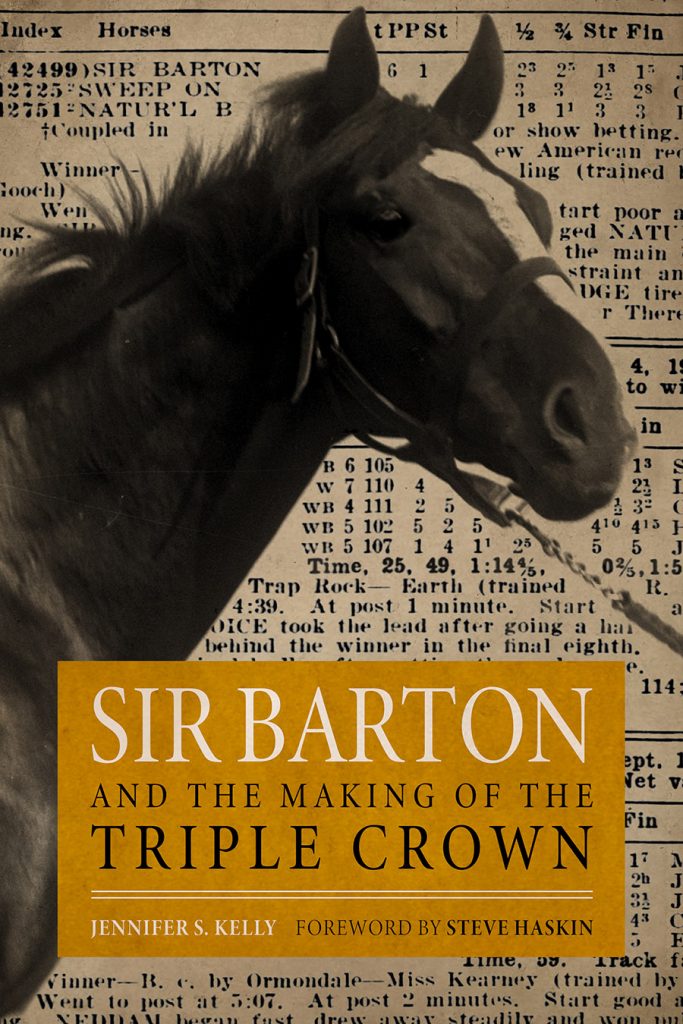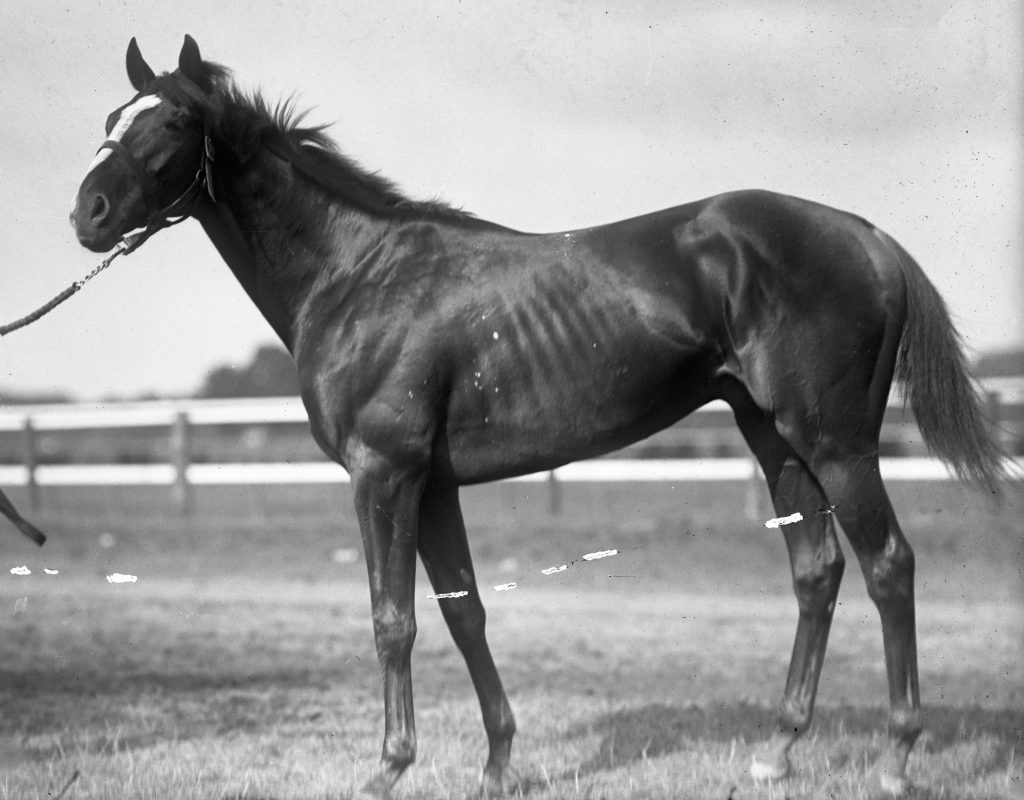
Welcome to Past The Wire’s Holiday “Author’s Corner” Book Guide. We offer you stories by the authors of six amazing and diverse books for gift-giving or a great holiday read. Information for purchasing is at the end of each article. Enjoy and Happy Holidays from all at PTW!
By Jennifer Kelly
When I undertook the task of writing Sir Barton and the Making of the Triple Crown, I knew the basic gist of his story. I watched the Jewels of the Crown documentary, narrated by Jim McKay, many times over the intervening years between receiving that VHS tape as a gift and committing to the task of exploring his story in depth. I knew about the rabbit, the quick succession of wins, and the seemingly ignominious finale to his career and his life.
One of the goals of writing the book was to flesh out the details of Sir Barton’s career, from his 0-for-6 two-year-old season to his defeat by one of the century’s greatest racehorses. Surely, in between that first start at Aqueduct in July 1918 and that final one at Kenilworth Park in 1920, lay a rich story of the nuances and happenstances that come to define any historical event.
Buried in two different articles, short items mentioned in passing, was a piece of information that I had never seen before whenever I read about Sir Barton’s road to the Belmont Stakes. In the years of research, I did to tell the story of America’s first Triple Crown winner, the thousands of articles and other sources I went through, these two seemingly innocuous pieces held what I thought was the key to the first Triple Crown – and beyond.
Sir Barton Ascendant

Sir Barton courtesy of Keeneland Library Cook Collection
After Sir Barton surprised everyone – except those who singled him out in the press beforehand – by winning the Kentucky Derby, he set a precedent with his Preakness win four days later, the first Derby-Preakness double ever. This came only a year after War Cloud became the first horse to compete in all three of what we now know as the Triple Crown series. Suddenly, within a year, the ground was laid for Sir Barton to make the trip from Louisville to Baltimore and show that it was worth the risk and the expense and the time to try for this double. After that victory at Pimlico, the stable moved to New York for the spring season at Belmont.
At Belmont, Sir Barton continued his winning ways with a victory in the Withers Stakes on May 24th, ten days after the Preakness and two weeks after the Derby. In a short span of time, the colt had won three prestigious stakes races, each with their own rich history of great horses crossing the finish line first. As is the case today, Sir Barton was nominated for multiple stakes races, each possible targets for the next start, the next win. In early June, his name appeared on the nominations list for the Latonia Derby and the Belmont Stakes.
The Latonia Derby, run at Latonia Race Track near Cincinnati, was 1¼ miles, the same distance as the Kentucky Derby; the Belmont Stakes was 1 3/8 miles, with the change to the familiar 1½ miles still seven years away. One was slated for June 7th and the other for June 11th. To run in the Latonia Derby meant a train ride from New York to northern Kentucky, which would take at least a day. To run in the Belmont Stakes, though, would mean running of his own stall at the Elmont, New York track. The purse for the Latonia Derby was $5,000 more than the Belmont Stakes so clearly the extra money held sway for trainer H.G. Bedwell and owner Commander J.K.L. Ross.
That is, until something unexpected arose. A small thing that became something bigger and then something historic.
Small Becomes Big
In late May, H.G. Bedwell sent Ross’s good older horse Cudgel west to Louisville for the Kentucky Handicap at Churchill Downs. The five-year-old had been part of Ross’s buying spree in 1918, as he built a championship stable that included Billy Kelly, who had been one of the best two-year-olds of 1918 and had finished second to Sir Barton in the Kentucky Derby; the filly Milkmaid, who was traveling with Cudgel for her try at the Kentucky Oaks; and Sir Barton himself, whom Ross had purchased at Saratoga in August 1918. Bedwell ordered assistant trainer Cal Shilling to scratch Cudgel from the Kentucky Handicap if the track was muddy. Heavy rain in the days before the race made the track a sloppy mess, so Cudgel was put on a train back to New York.
He brought with him something that seems innocuous: a bad cold. The thing about a horse with a cold is that much like with humans, close proximity within a barn tends to spread the germs around. Sure enough, by June 4th, H.G. Bedwell informed racing officials at Latonia that Sir Barton would not be traveling to Covington, Kentucky for the Latonia Derby. Not only would Sir Barton not start in that race, but Cudgel would not run in the Suburban Handicap at Belmont either. Instead, Sir Barton would start in the Belmont Stakes on June 11th, enough time for the Derby-Preakness victor to recover from his cold and be ready to face the starter for that stakes race.
Of course, you already know what happens next: Sir Barton faces only two others in the Belmont Stakes and wins easily, setting an American record for 1 3/8 miles in the process. Though it would take about three decades to solemnize, that win seals the first Triple Crown in American history. It would be another four years before turf writers would coalesce those three races into a ‘triple crown’ and another decade after that before it would earn capital letters. After a few fits and starts with scheduling the three races, Gallant Fox becomes the second horse to win all three in 1930 and his son Omaha in 1935. By 1950, when Commander Ross was awarded the first of the triangular Tiffany trophies in recognition of Sir Barton’s achievement in 1919, eight horses had etched their names on that rare list. Since 1950, five more horses have joined that elite club, a testament to the immense challenge of winning all three of these classic races.
All of this because a stablemate had a cold and gave it to Sir Barton.

After calling riders up, Jennifer Kelly stands with Todd Pletcher after his win in the Sir Barton Stakes with King for a Day at Pimlico May 17, 2019.
The Next Surprise
As I work on my second book, tentatively titled Foxes of Belair: Gallant Fox, Omaha, and the Quest for the Triple Crown, I am reminded of the happenstances, the small moments that grow into big ones, those rich details that color our lives and sometimes are the catalysts for historic events. Every time I embark on a search for information on a horse or an event, I am reminded of that surprising discovery and wonder if another one is right around the corner. What will the next surprising tidbit be?
Book cover photo courtesy of the University Press of Kentucky
___________________________________
If you want to learn more about Sir Barton and his Hall of Fame career, look for Sir Barton and the Making of the Triple Crown, published by the University Press of Kentucky, at your favorite bookstore or order from most online booksellers, including Amazon, Barnes & Noble, and the UPK website. I hope you will join me on Twitter and Instagram at either @thesirbarton or @foxesofbelair and follow the progress of Foxes of Belair at foxesofbelair.com



